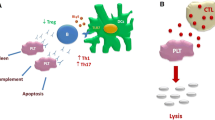Abstract
We are developing two fusion proteins consisting of a diphtheria toxin (DT) linked to either granulocyte macrophage colony stimulating factor (DT388-GMCSF) or interleukin-3 (DT388-IL3). In trials, patients with anti-DT IgG concentrations >2.5 μg/ml had significantly lower concentrations of either fusion protein. DT389-IL2 is currently FDA approved for the treatment of cutaneous T-cell lymphomas. We noted increased concentrations of anti-DT IgG after administration of platelet concentrates (PC). Because many of these patients require transfusions, we measured the anti-DT IgG content of FFP and PC. We assayed 14 bags of FFP and 12 bags of single-donor PCs for anti-DT IgG by an enzymoimmunoassay against DT389-IL2, DT388-IL3, DT388-GMCSF. The median (percent of samples positive) of anti-DT IgG concentrations in PC against DT388-GMCSF, DT388-IL3, DT389-IL2 was 0.8 μg/ml (83%), 0.7 μg/ml (83%), and 0.3 μg/ml (58%), respectively. The median (percent of samples positive) anti-DT IgG concentration in FFP against DT388-GMCSF, DT388-IL3, and DT389-IL2 was 2.1 μg/ml (86%), 1.9 μg/ml (93%), and 1.4 μg/ml (86%), respectively. There was a strong association between anti-DT389IL2 IgG, anti-DT388IL3 IgG, and anti-DT388GMCSF IgG concentrations in both the FFP (95.6%) and PC (76.3%). Assuming a plasma volume of 3 l in a 70 kg patient, a single FFP unit would increase the plasma anti-DT389IL2 IgG, anti-DT388IL3 IgG, and anti-DT388GMCSF IgG by 0.13 μg/ml, 0.17 μg/ml, and 0.19 μg/ml, respectively. For PC, a single unit would increase plasma anti-DT389-IL2 IgG, anti-DT388-IL3 IgG, and anti-DT388-GMCSF IgG by 0.03 μg/ml, 0.06 μg/ml, and 0.07 μg/ml, respectively. In conclusion, a single FFP or PC appears to minimally increase anti-DT IgG concentrations, but multiple units may significantly do such.
Similar content being viewed by others
References
Anonymous (2001) The body fluid compartments: extracellular and intracellular fluids: interstitial fluid and edema. In: Guyton AC, Hall JC (eds) Textbook of medical physiology. 10th edn. W.B. Saunders, Philadelphia, pp 264–278
Choe S, Bennett MJ, Fujii G, Curmi PMG, Kantardjieff KA, Collier RJ, Eisenberg D (1992) The crystal structure of diphtheria toxin. Nature 357:216–222
Cooperative Group for the Study of Immunoglobulin in Chronic Lymphocytic Leukemia (1988) Intravenous immunoglobulin for the prevention of infection in chronic lymphocytic leukemia. N Engl J Med 319:902–907
Feuring-Buske M, Frankel AE, Alexander RL, Gerhard B, Hogge D (2002) A diphtheria toxin-interleukin 3 fusion protein is cytotoxic to primitive acute myeloid leukemia progenitors but spares normal progenitors. Cancer Res 62:1730–1736
Frankel AE, Fleming DR, Hall PD, Powell BL, Black JH, Leftwich C, Gartenhaus R (2003) A phase II study of DT fusion protein denileukin diftitox in patients with fludarabine-refractory chronic lymphocytic leukemia. Clin Cancer Res 9:3555–3561
Frankel AE, Hall PD (2002) Bacterial and plant toxins—general mode of action. In: Lorberboun-Galski H, Laarovici P (eds) Chimeric toxins: mechanisms of action and therapeutic applications. 1st edn. Taylor & Francis, London, pp 1–13
Frankel AE, Powell BL, Hall PD, Case LD, Kreitman RJ (2002) Phase I trial of a novel diphtheria toxin/GM-CSF protein (DT388GMCSF) for refractory or relapsed acute myeloid leukemia. Clin Cancer Res 8:1004–1013
Frankel AE, Ramage J, Latimer A, Feely T, Delatte S, Hall P, Tagge E, Kreitman R, Willingham M (1999) High level synthesis and maximal purification of the recombinant diphtheria fusion toxin DTGM for phase I clinical trials. Protein Expr Purif 16:190–201
Hall PD, Razzouk BI, Willoughby TE, McLean TW, Frankel AE (2002) The majority of children and adolescents with acute myeloid leukemia have detectable anti- DT388GMCSF IgG concentrations but at concentrations that do not preclude in vivo activity. J Ped Hematol Oncol 24:521–526
Hall PD, Virella G, Willoughby T, Atchley DH, Kreitman RJ, Frankel AE (2001) Antibody response to DT-GM, a novel fusion toxin consisting of a truncated diphtheria toxin linked to human granulocyte-macrophage colony stimulating factor (GM), during a phase I trial of patients with relapsed or refractory acute myeloid leukemia. Clin Immunol 100:191–197
Olsen E, Duvic M , Frankel A, Kim Y, Martin A, Vonderheid E, Jegasothy B, Wood G, Gordon M, Heald P, Oseroff A, Pinter-Brown L, Bowen G, Kuzel T, Fivenson D, Foss F, Glode M, Molina A, Knobler E, Stewart S, Cooper K, Stevens S, Craig F, Reuben J, Bacha P, Nichols J (2001) Pivotal phase III trial of two dose levels of denileukin diftitox for the treatment of cutaneous T-cell lymphoma. J Clin Oncol 19:376–388
Rebulla P, Finazzi G, Marangoni F, Avvisati G, Gucliotta L, Tognoni G, Barbui T, Mandelli F, Scirchia G (1997) The threshold for prophylactic platelet transfusions in adults with acute myeloid leukemia. N Engl J Med 337:1870–1875
Urieto JO, Liu TF, Black JH, Cohen KA, Hall PD, Willingham MC,Pennell LK, Hogge DE, Kreitman RJ, Frankel AE (2004) Expression and purification of the recombinant diphtheria fusion toxin DT388IL3 for phase I clinical trials. Protein Expr Purif 33:123–133
Yamaizumi M., Mekada E., Uchida T., Okada Y (1978) One molecule of diphtheria toxin fragment A introduced into a cell can kill the cell. Cell 15:245–250
Acknowledgements
The authors acknowledge the cooperation of the Division of Clinical Pathology in the Department of Pathology and Laboratory Medicine at the Medical University of South Carolina for providing the expired blood products. The authors thank the National Institutes of Health for grant support. The authors also acknowledge the technical assistance of Anne Patala, Christol Cole, McKenzie Turner, Shelly Bratcher, and Robin Minhinnett.
Author information
Authors and Affiliations
Corresponding author
Rights and permissions
About this article
Cite this article
Hall, P.D., Sinha, D. & Frankel, A.E. Fresh frozen plasma and platelet concentrates may increase plasma anti-diphtheria toxin IgG concentrations: implications for diphtheria fusion protein therapy. Cancer Immunol Immunother 55, 928–932 (2006). https://doi.org/10.1007/s00262-006-0124-z
Received:
Accepted:
Published:
Issue Date:
DOI: https://doi.org/10.1007/s00262-006-0124-z




